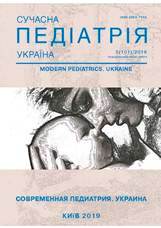Readiness of general practitioners-family doctors on the prevention of children’s premature death: according to sociological research
Abstract
Purpose — to study and analyze the level of knowledge of general practitioners-family doctors in preventing the premature death of children, to determine ways of increasing their awareness on this problem.Materials and methods. Sociological survey was conducted of 400 general practitioners, family doctors, who live in Kiev, Kiev and Zakarpattya regions. The majority of respondents are represented by general practitioners-family doctors working in cities (65.75%), over the age of 40 years (66.25%), women made up (82.25%), the number of doctors trained on specialization course «general medical practice — family medicine» (73.25%), doctors who has certificate for the highest (38.50%) and first (32.75%) certification categories working in medical ambulatories (90.75%). The study was conducted according to a specially designed questionnaire. Research methods: mathematical, sociological survey (questioning), statistical, analytical, comparative analysis.
Results. Sociological study established an insufficient level of readiness of general practitioners — family doctors to prevent children's premature mortality: respondents rated their theoretical knowledge of the tactics of actions as insufficient for conditions that threaten a child's life, such as traumatic brain injury (12.25±1.6%), acute asphyxia (9.25±1.4%), burns, including respiratory tract (8.5±1.4% and 8.0±1.4%, respectively), convulsions (7.75±1.3%). The least general practitioners — family doctors possess practical skills in providing medical care for children with traumatic brain injury (16.0±1.8%), croup (15.5±1.8%), and respiratory tract burns (11.5±1.6%), convulsions (10.5±1.5%). The explanatory regular educational work of general practitioners — family doctors with parents on maintaining children's health and learning tactics for conditions that threaten a child's life has low level (21.25±2.0% of respondents organized the work of the school of responsible parenthood, 15.75±1.8% taught parents tactics in conditions that threaten a child's life).
Conclusions. The established insufficient level of theoretical knowledge and practical skills of general practitioners — family doctors in tactics of action in certain conditions that threaten the threaten a child's life requires doctors to be trained on the competent and qualification levels of knowledge in helping children and preventing child mortality.
The research was carried out in accordance with the principles of the Helsinki Declaration. The study protocol was approved by the Local Ethics Committee (LEC) of all institutions.
References
WHO. (2018, Sept 19). Children: reducing mortality. https://www.who.int/ru/news-room/fact-sheets/detail/children-reducing-mortality.
WHO. Maternal, newborn, child and adolescent health. Integrated Management of Childhood Illness. https://www.who.int/maternal_child_adolescent/topics/child/imci/ru/.
WHO. (2019, 27 Feb). Primary health care. https://www.who.int/ru/news-room/fact-sheets/detail/primary-health-care.
Every Woman Every Child. Saving lives, protecting futures: Progress report on the Global Strategy for Women's and Children's Health. (2015). New York: United Nations.
Gera T, Shah D, Garner P, Richardson M, Sachdev HS. (2016). Cochrane Review: Integrated Management of Childhood Illness (IMCI) Strategy for children under five (in press). Cochrane Database of Systematic Reviews. 6(CD010123). https://doi.org/10.1002/14651858.CD010123.pub2; PMCid:PMC4943011
Jamison DT, Summers LH, Alleyne G, Arrow KJ et al. (2013). Global health 2035: a world converging within a generation. The Lancet. 382(9908): 1898–955. https://doi.org/10.1016/S0140-6736(13)62105-4
Kuruvilla S, Schweitzer J, Bishai D, Chowdhury S et al. (2014). Success factors for reducing maternal and child mortality. Bull World Health Organ. 92(7): 533–44B. https://doi.org/10.2471/BLT.14.138131; PMid:25110379 PMCid:PMC4121875
Marleen Temmerman, Rajat Khosla, Zulfiqar A Bhutta, Flavia Bustreo. (2015). Towards a new Global Strategy for Women's, Children's and Adolescents' Health. The BMJ. 351;1. https://doi.org/10.1136/bmj.h4414; PMid:26371228
Resolution WHA 69.2. Committing to implementation of the Global Strategy for Women's, Children's and Adolescents' Health. 69th World Health Assembly, Geneva, 28 May 2016. http://apps.who.int/gb/ebwha/pdf_fi/les/WHA69/A69_R2-en.pdf
Sustainable Development Goals (SDGs). (2015). New York: United Nations. https://sustainabledevelopment.un.org.
The Global Strategy on Women's, Children's and Adolescents' Health (2016-2030). (2015). New York: United Nation. https://www.everywo/maneverychild.org/wpcontent/uploads/2016/12/EWEC_Global_Strategy_EN_inside_LogoOK_web.pdf.
UNICEF, WHO. (2015). A Decade of Tracking Progress for Maternal, Newborn and Child Survival: The 2015 Report. Geneva: WHO.
WHO. (1998). Child Health Division. Improving family and community practices: A component of the IMCI strategy. Geneva: WHO.
WHO. (2008). Primary health care now more than ever: тhe world health report. http://www.who.int/whr/2008/ whr08_en.pdf.
WHO. (2013). Health 2020. A European policy framework and strategy for the 21st century. http://www.euro.who.int/__data/assets/pdf_file/0011/199532/Health2020-Long.pdf?ua=1
WHO. (2013). The Partnership for Maternal, Newborn & Child Health, Partners in Population and Development. Promoting women's empowerment for better health outcomes for women and children. Geneva: WHO. http://www.who.int/pmnch/knowledge/publications/strategybriefs/sb_gender.pdf.
WHO. (2014). The Partnership for Maternal, Newborn & Child Health, WHO. A policy guide for implementing essential interventions for reproductive, maternal, newborn and child health (RMNCH): a multisectoral policy compendium. Geneva: WHO.
WHO. (2014). WHO recommendation on community mobilization through facilitated participatory learning and action cycles with women's groups for maternal and newborn health. Geneva: WHO.
Downloads
Issue
Section
License
The policy of the Journal “MODERN PEDIATRICS. UKRAINE” is compatible with the vast majority of funders' of open access and self-archiving policies. The journal provides immediate open access route being convinced that everyone – not only scientists - can benefit from research results, and publishes articles exclusively under open access distribution, with a Creative Commons Attribution-Noncommercial 4.0 international license (СС BY-NC).
Authors transfer the copyright to the Journal “MODERN PEDIATRICS. UKRAINE” when the manuscript is accepted for publication. Authors declare that this manuscript has not been published nor is under simultaneous consideration for publication elsewhere. After publication, the articles become freely available on-line to the public.
Readers have the right to use, distribute, and reproduce articles in any medium, provided the articles and the journal are properly cited.
The use of published materials for commercial purposes is strongly prohibited.

